Hand tracing drawing is a fantastic way to inspire your artwork and enhance your creativity. Start with simple shapes and gradually move to complex designs. Use your non-dominant hand to capture new perspectives while maintaining a steady hand for details. Incorporate light and shadow to add depth, and don't forget to experiment with mixed media techniques for unique effects. You can also engage in fun activities, like creating themed pieces or involving family in collaborative projects. Each trace helps develop your observation skills, laying a foundation for your artistic journey. Keep exploring for fresh ideas and techniques!
Key Takeaways
- Experiment with different hand positions and angles to create unique shapes and designs in your hand tracing artwork.
- Combine hand tracing with mixed media techniques, such as watercolors or markers, to enhance visual appeal and creativity.
- Use tracing as a foundation to build complex compositions, layering additional elements and details for depth and interest.
- Engage with family or friends in collaborative hand tracing projects, fostering creativity and shared artistic expression.
- Incorporate storytelling elements into your hand tracing, creating narratives that resonate emotionally with viewers.
Basic Techniques
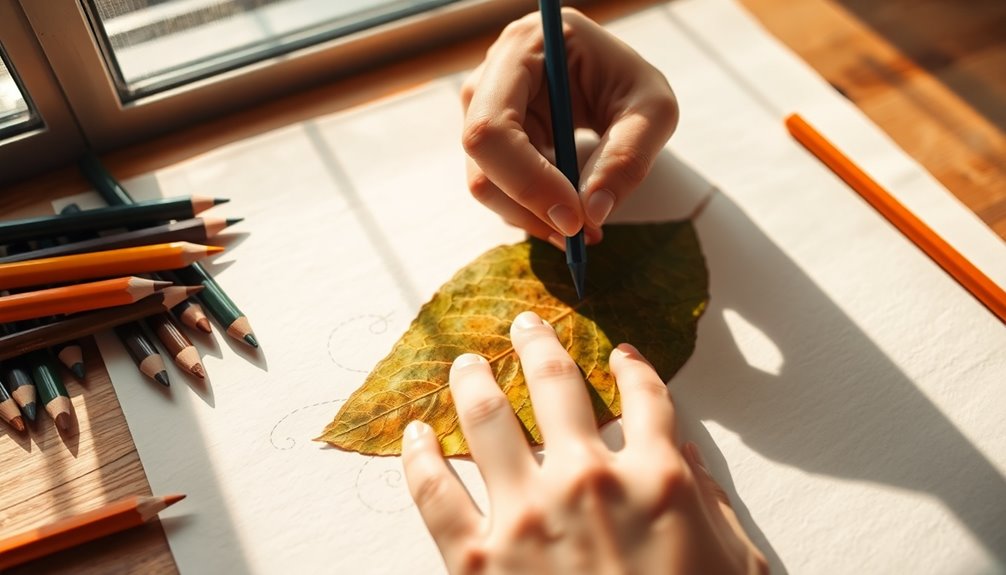
When you're ready to start hand tracing, preparation is key to achieving a great result. First, gather your materials: a piece of paper and a pencil.
Choose the hand that isn't your dominant one for tracing, and hold the pencil straight up and down to ensure accuracy. Keep your hand steady with fingers apart, focusing on capturing every detail, including wrinkles and any jewelry.
When tracing, use a continuous line and move slowly to truly observe your hand. Wrap your pencil around each finger to avoid missing details, and don't hesitate to use an eraser for any mistakes. This methodical approach sets a solid foundation for your creative journey ahead! Remember to consider using various coloring tools to enhance your artwork after tracing.
Enhancing Creativity
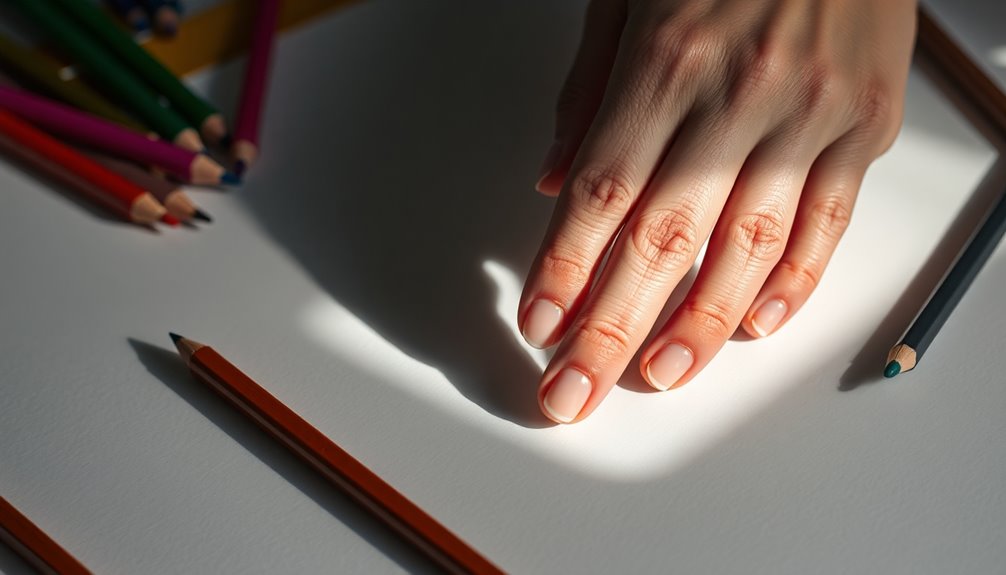
Although creativity can sometimes feel elusive, hand tracing offers a unique pathway to unlock your artistic potential. By tracing, you develop muscle memory, enhancing your drawing skills over time. It also improves your stylus control, making digital painting smoother. As you focus on tracing, you sharpen your observation skills, allowing you to notice intricate details more accurately. Tracing simplifies complex subjects into manageable shapes, making them easier to tackle. Plus, it can be a creative exercise in itself, encouraging you to experiment with various techniques. Tracing exercises can help familiarize you with different styles and techniques, adding another layer to your artistic practice.
Incorporating daily art prompts can further boost your creativity, guiding your artistic journey and helping you build a consistent practice.
Embrace these methods to elevate your artistry and explore new heights.
Practical Applications
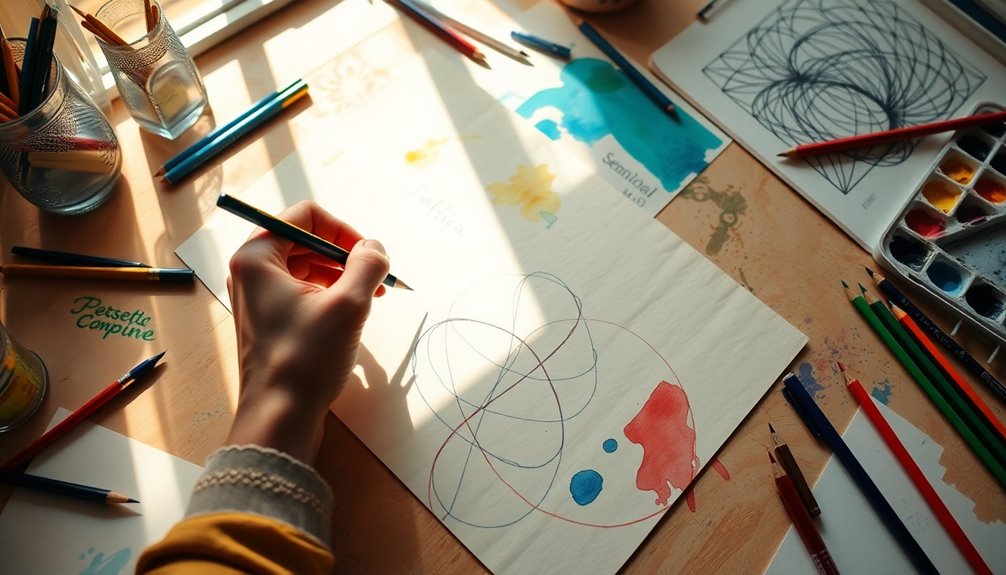
Hand tracing opens up a world of practical applications that extend beyond mere artistic exploration.
In educational settings, you can use tracing to enhance hand-eye coordination and fine motor skills in children. It's perfect for art projects, like creating handprint art, or engaging classroom activities tailored for various age groups. Additionally, the activity allows students to explore creativity in a fun and engaging way.
Tracing also offers therapeutic benefits, serving as a calming technique while improving dexterity through occupational therapy. You can create unique art pieces or personalized gifts, combining tracing with other media for added flair.
Additionally, tracing can aid in data collection for research purposes, analyzing stroke data or studying the drawing process, providing valuable insights into both artistic and cognitive development.
Advanced Techniques
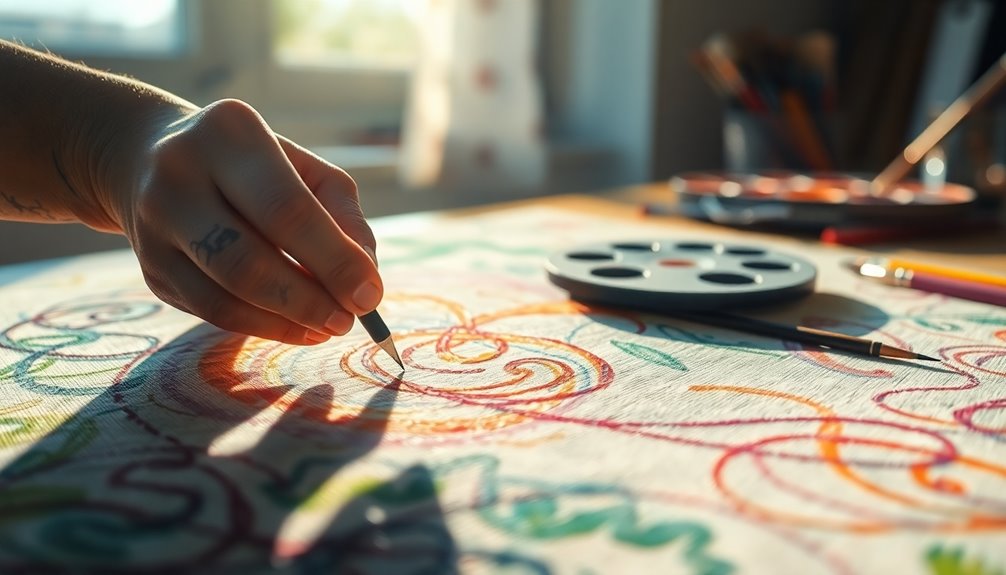
Exploring advanced techniques in hand tracing can elevate your drawing skills and deepen your understanding of form.
Start with gesture drawing, using dynamic strokes to capture movement and axis lines to align key body landmarks. Simplify fingers into cylindrical segments, paying attention to ellipses for spatial orientation and thumb placement.
Next, incorporate light and shadow; create basic volumes while maintaining a consistent lighting scheme. Note shadow patterns on the fingers and thumb to add depth. Understanding musculoskeletal anatomy can further enhance your ability to depict the hand accurately.
Finally, practice contour drawing by focusing on outer edges with a continuous line, enhancing your hand-eye coordination. Include details like wrinkles and jewelry, and refine your lines for accuracy.
These methods will transform your hand tracing into more expressive and realistic artwork.
Tips for Success
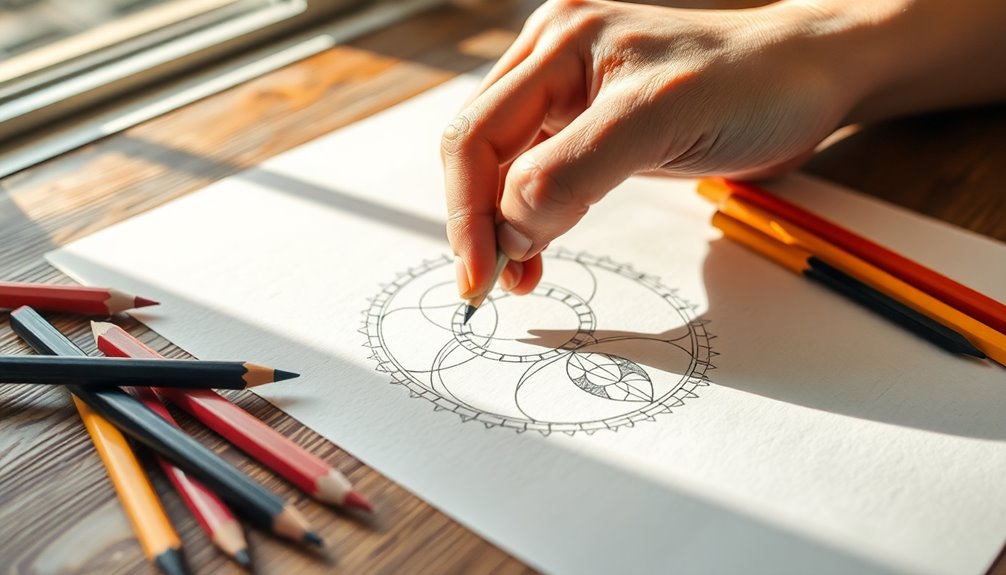
To achieve success in hand tracing, it's essential to approach your practice with intention and focus.
Start by gathering high-quality reference images and choosing the right tools, like a light-colored layer in Photoshop or a good pencil. Set clear goals for your drawing and take the time to understand the subject's anatomy and proportions. Additionally, remember that tracing aids in understanding shapes and proportions, which can significantly enhance your learning experience. Using eco-friendly practices while creating your artwork can also contribute positively to your environment.
When tracing, use a low opacity layer, focus on simple outlines, and move slowly to capture details accurately. Pay attention to smaller features and refine your work as needed.
Improve your observation skills by measuring distances and noting textures.
Lastly, seek feedback from others, analyze your mistakes, and repeat studies to enhance your accuracy and overall skill.
Fun Activities
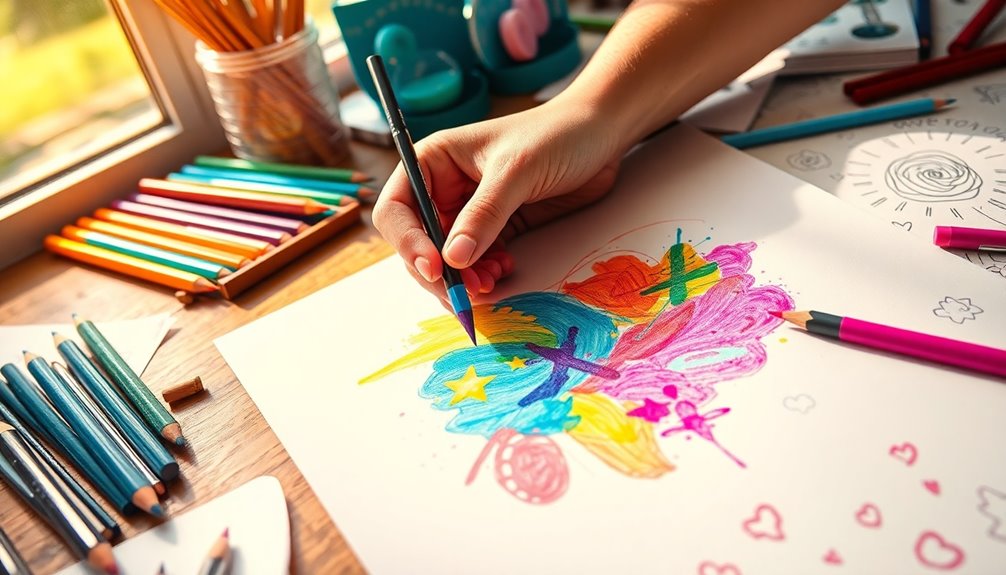
While engaging in hand tracing, you can turn a simple activity into a fun and creative experience. Try drawing adorable animals like cheerful kittens or playful dinosaurs by tracing your hands.
For holidays, create festive designs, like stylish llamas for Thanksgiving. You can also spread your fingers wide to craft colorful octopuses or visionary snails. This activity not only sparks imagination but also boosts coordination and speech development in children. Experiment with different hand positions and add personal touches like rings or tattoos to make your drawings unique. Encouraging children to explore a variety of creative themes, such as the vibrant colors of masquerade masks symbolism, can further enhance their artistic expression. By diving into different cultural designs, kids can learn about their meanings while having fun. Engaging in this imaginative play not only entertains them but also cultivates important cognitive skills as they integrate art with storytelling.
Gather family members for group projects, encouraging everyone to express their creativity by choosing their favorite animals and colors. The possibilities are endless, making hand tracing a joyful artistic adventure! Additionally, this craft activity serves as an anti-stress activity for all ages, allowing everyone to unwind and enjoy the process.
Unique Hand Tracing Ideas
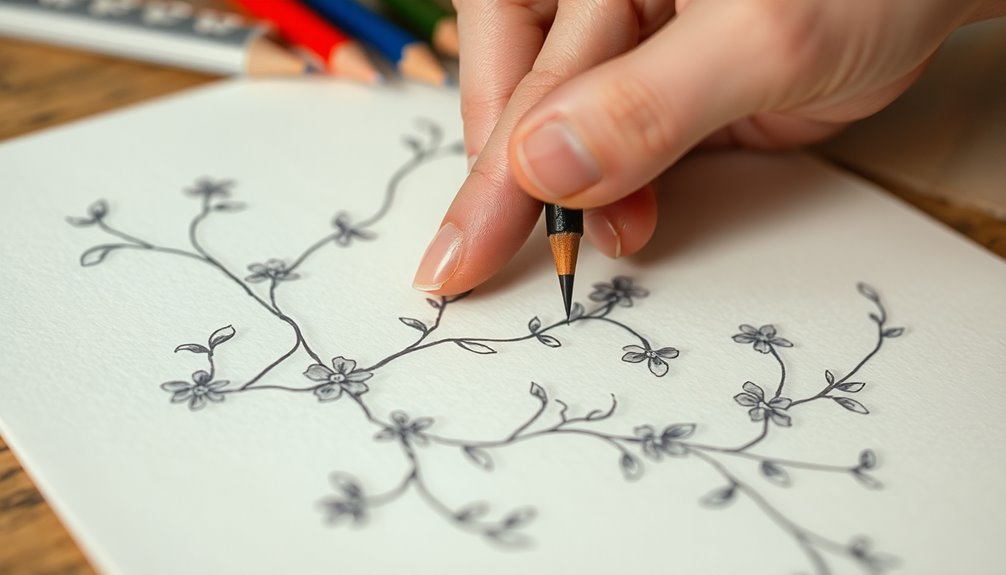
Hand tracing opens up a world of creativity, allowing you to transform simple outlines into unique designs. You can create fun animal drawings like a giraffe with extended fingers or a zebra by adding stripes to your palm print. This activity not only encourages artistic exploration but also helps develop fine motor skills as you trace and color.
Nature-inspired designs are equally captivating; consider crafting a flamingo by tilting your palm and adding pink details. Cartoon characters can also come to life—try a dog by sticking out your thumb or an octopus with spread fingers.
For seasonal themes, make a Thanksgiving turkey or a Christmas tree using your hand's natural shape. Each idea invites you to explore your artistic side and personalize your creations, making hand tracing an enjoyable and imaginative activity!
Incorporating Mixed Media
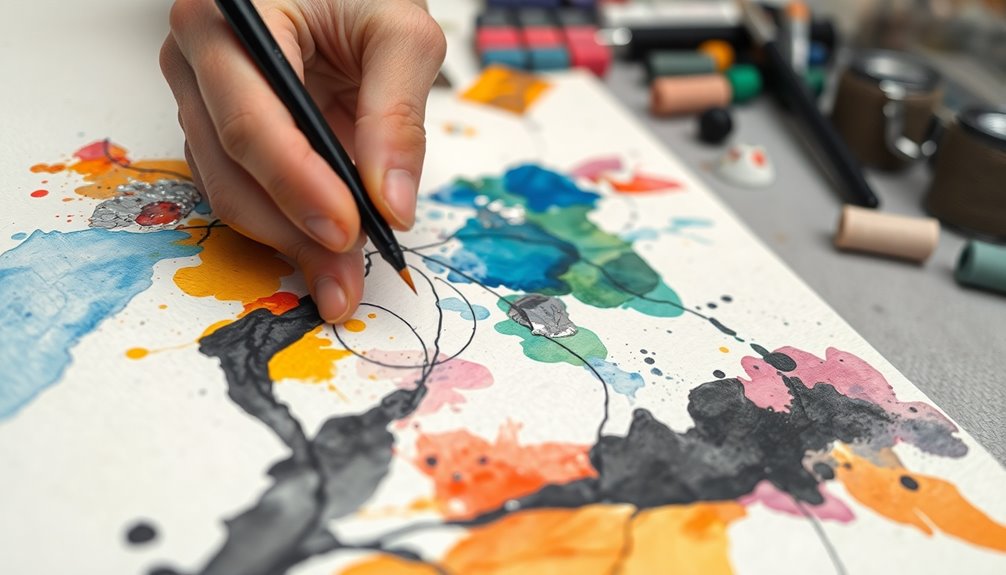
Incorporating mixed media into your hand tracing projects can elevate your artistic expression and spark new ideas. You can enhance your tracing by combining traditional techniques with digital art, using tools like digital brushes and layers to add textures and patterns. Experiment with fabric, string, or textured papers to bring depth and dimension to your work. Try layering and stitching to create visually engaging pages. Don't forget color! Use crayons or markers to fill in your hand tracings with vibrant hues and unique patterns. Lastly, consider adding written reflections or quotes to deepen the connection between your thoughts and the artwork. This blend of materials and techniques will inspire creativity and make your art journal truly one-of-a-kind. Additionally, incorporating various art techniques allows for a more diverse exploration of creativity in your hand tracing projects.
Showcasing Your Artwork
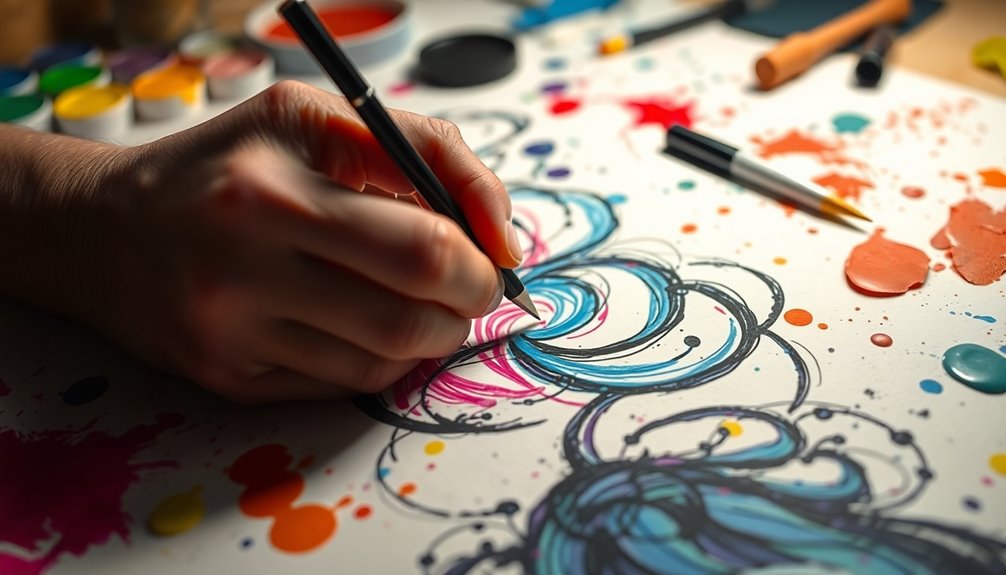
Showcasing your artwork effectively can transform how others perceive your creativity. Start by choosing a bright, contrasting background to make your pieces pop. Frame your art for a professional touch and protection, and group similar works together to create a cohesive collection. Highlight key elements, focusing on bold lines and vibrant colors.
Don't forget to rotate your artwork regularly to keep things fresh!
When arranging your pieces, balance the elements and consider a theme-based composition that tells a story. Add final touches with sharpies for detail, clean up any pencil lines, and review your layout. Incorporating contour drawing techniques can enhance the visual appeal of your artwork and showcase your unique style.
Incorporate mixed media or contour techniques to further engage your audience and showcase your unique style.
Frequently Asked Questions
What Age Is Suitable for Hand Tracing Activities?
Hand tracing activities are suitable for children as young as two years old. At this age, they start developing fine motor skills and pre-writing abilities through simple tracing.
As they grow, around four years, they can explore crayon tracing and engage in sensory activities.
By age five, they're ready to print letters and refine their drawing skills.
Each stage builds essential skills, enhancing their creativity and preparing them for more complex tasks ahead.
Can Hand Tracing Be Used for Digital Art?
Did you know that over 60% of digital artists use tracing techniques to enhance their work?
Yes, hand tracing can definitely be used for digital art! You can create a hand-drawn sketch, photograph it, and trace it in apps like Procreate or Photoshop.
This method allows you to maintain the original charm of your drawing while refining it digitally.
Just remember to use layers for ease and flexibility in your creative process!
How Do I Preserve Hand Tracing Artworks?
To preserve your hand tracing artworks, use acid-free materials for storage and frame them with UV-resistant glass.
Keep them in a cool, dry place, away from moisture and direct sunlight. Handle your pieces gently to avoid damage.
Additionally, scan your artwork at a high resolution to create a digital copy, saving it in a quality format.
This way, you can ensure your creations remain vibrant and intact for years to come.
Are There Any Health Concerns With Tracing?
Have you ever considered the health concerns linked to tracing?
While it can be a fun activity, excessive tracing might lead to issues like anxiety, headaches, and even repetitive strain injuries.
You might find that your concentration suffers or that it causes emotional distress if it becomes compulsive.
It's essential to stay aware of how tracing affects your physical and mental well-being, ensuring it remains a positive experience in your life.
Can Hand Tracing Be Combined With Other Art Forms?
Absolutely, you can combine hand tracing with other art forms!
For instance, trace your hands and then paint them in vibrant colors, or use the shapes as templates for collages.
You might also explore digital art by tracing your hands and editing them on a computer.
Even in 3D art, you could mold your traced shapes into unique models.
These combinations enhance creativity and allow you to experiment with different techniques!
Conclusion
Hand tracing offers a unique way to unleash your creativity and express your artistic vision. With the techniques and ideas shared, you're ready to explore new dimensions in your artwork. Why not take a moment to try a hand tracing project today? You might find inspiration in the simplest shapes! Remember, every trace is a step toward discovering your unique style, so dive in and let your imagination run wild!









